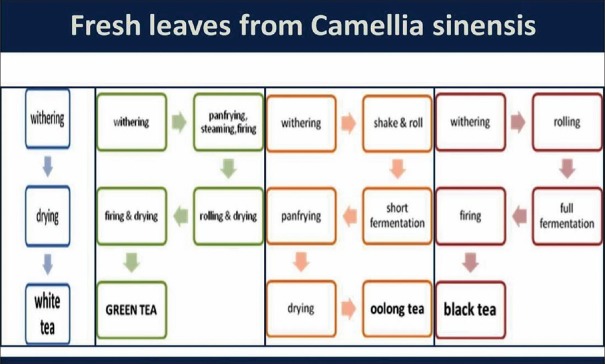Abstract
Tea is produced from the Camellia sinensis plant and can generally be divided into categories based on how they are processed. In general, green tea that is unfermented C. sinensis has been considered superior to black tea in health benefits. It contains a unique set of catechins that possess biological activity as antioxidant, anti-inflammatory and antiproliferative, which is potentially significant to the prevention and treatment of various forms of diseases. Oral cavity oxidative stress and inflammation, consequent cigarettes due to nicotine and acrolein, may be reduced in the presence of green tea polyphenols. In addition, green tea polyphenols can close down halitosis through modification of odorant sulfur components. Usually, green tea defends healthy cells from malignant transformation and locally has the ability to induce apoptosis in oral cancer cells. In unison, there is an increasing implication in the health benefits of green tea in the field of oral health. This review will cover recent findings on the therapeutic properties and anticancer health benefits of green tea.
Keywords: Antioxidants, Camellia sinensis, cancer, tea
INTRODUCTION
Tea is made from the leaves of Camellia sinensis and is one of the most widely consumed beverages in the world.[1] The tea plant is believed to have originated in the landmass encompassing Tibet, Western China and Northern India. Drinking the beverage tea has been considered a health-promoting habit since ancient times. The modern medicinal research is providing a scientific basis for this belief. The evidence supporting the health benefits of tea drinking grows stronger with each new study that is published in the scientific literature. In the last couple of years, green tea has gained popularity in the Western countries due to scientific findings that show the health potentials of the beverage. C. sinensis is a plant which yields a variety of tea which can be categorized into four types, depending on the level of fermentation.[2,3,4] The preparation of four different types of tea is illustrated in Figure 1.[5,6]
Figure 1.
Processing of tea
Green tea (unfermented) - It is prepared in such a way to preclude the oxidation of green leaf polyphenols
Black tea (fermented) or red tea (Pu-Erh) - During its production, oxidation is promoted so that most of these substance are oxidized
Oolong (partially fermented) - It is partially oxidized
White tea - it is made from new growth buds and young leaves that have been steamed to inactivate polyphenol oxidation and then dried.
The 78% of the tea consumed worldwide is black, only about 20% is green and <2% is oolong tea.[7] Usually, black tea is consumed in the United States, oolong tea is most popular in China and Taiwan and green tea is most popular in China, Japan and Korea.[6] Among the health benefits that have been studied using green tea are as an antioxidant, anti-inflammatory, anticarcinogenic, in cardiovascular health, oral health and as an antimicrobial. This article provides a critical review of oral benefits of green tea, discusses the possible common mechanisms involved and evaluates the human relevance of the published health effects.
Chemical composition of green tea
Green tea is a complex mixture of precious compounds including polyphenols, flavonoids, flavonols and other constituents such as amino acids, organic acids, lipids, vitamins, polysaccharides and thiamine [Table 1]. The major components of green tea are the polyphenols, and the major polyphenols (called catechins) are flavonoids.[8] Green tea also contains garlic acid, quercetin, kaempferol, myricetin and chlorogenic acid along with some amount of caffeine although half of that found in coffee [Table 2].[9,10,11] One cup of green tea usually contains about 300–400 mg of polyphenols and between 50 and 100 mg of caffeine. Green tea commercially is available as bottled and sweetened with sugar or an artificial sweetener, in single tea bags, loose-leaf and in instant-powder. Green tea supplements are sold in capsule form or liquid extracts.
Table 1.
Constituents of green tea with percentage of catechin in green tea
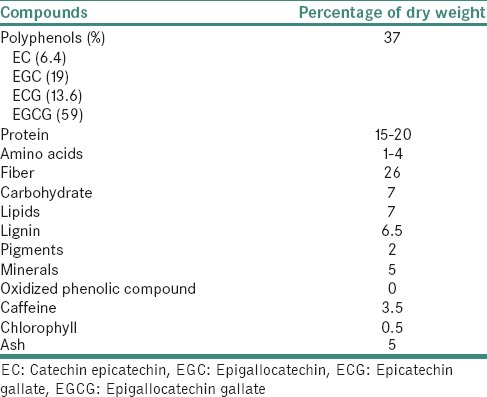
Table 2.
The average amount of caffeine found in coffee and tea
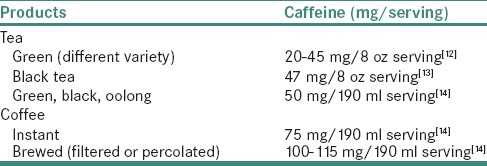
Mechanism of action
Green tea is rich in polyphenolic compounds, with catechins as its major component. Studies have shown that catechins possess diverse pharmacological properties that include antioxidative, anti-inflammatory, anticarcinogenic, antiarteriosclerotic and antibacterial effects. The primary pharmacologic action center around the antioxidant effects of green tea is polyphenols. Green tea inhibits reactive oxygen species (ROS) in the body which restrict the damage of DNA, RNA, oxidize protein, oxidize lipids and activation of cell suicide. Intake of green tea can stop all these degenerative changes by inhibiting the action of the ROS molecule [Figure 2].
Figure 2.

Mechanism of action of green tea
Therapeutic application
The health benefits of green tea (C. sinensis) catechins are becoming increasingly recognized day by day. In ancient times, green tea has been considered by the traditional Chinese medicine as a healthful beverage. Recent human studies suggest that green tea may contribute to maintenance of endothelial function and vascular homeostasis and an associated reduction in atherogenesis and cardiovascular disease risk reduction and some forms of cancer[12] as well as to the promotion of oral health and other physiological functions such as antihypertensive effect, solar ultraviolet protection, bone mineral density, antifibrotic properties, antioxidative,[13] antibacterial[14] and antivirasic activity[15] and neuroprotective power.[16] Other uses are listed in Table 3.[17,18,19,20,21,22,23,24,25,26,27,28,29,30,31,32,33,34,35] Tea catechins are well absorbed in the gastrointestinal tract, and they interact synergistically in their disease-modifying actions, thus drinking unfractionated green tea is the most simple and beneficial way to prevent gastrointestinal disorders. In the gastrointestinal tract, green tea was found to activate intracellular antioxidants, inhibit procarcinogen formation, suppress angiogenesis and cancer cell proliferation. Studies on the preventive effect of green tea in esophageal cancer have produced inconsistent results; however, inverse relationships of tea consumption with cancers of the stomach and colon have been widely reported.[24]
Table 3.
Various uses of green tea
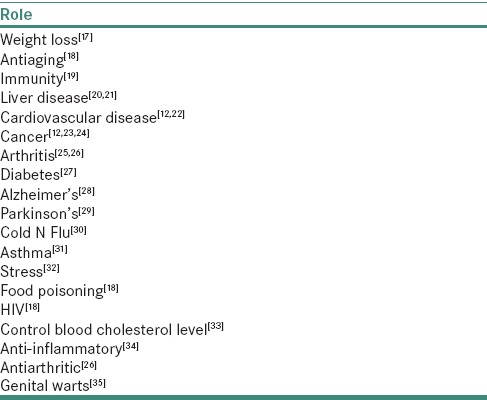
Green tea and oral health
Prevention of dental caries and plaque
Oral pathologies such as dental caries, periodontal diseases and teeth loss can greatly influence human health. Among those, dental caries is caused as a result of infectious diseases caused by numerous reasons related to nutrition and bacterial infections. Green tea protects against bacterial induced dental caries and plaque scores. It controls bacteria and lowers the acidity of saliva and dental plaque, which is nowadays considered to be useful tool in preventing cavities.[24,36,37,38] In recent researches, it has been shown that green tea prevents gathering of bacteria and therefore results in the formation of plaques on teeth which leads to decreasing construction of human amylase excretion, preventing glucosyltransferase and finally limiting glucan biosynthesis which gets stuck on teeth. In addition, it was specified that the routine consumption of green tea in human studies could reduce the intensity of teeth caries.[39,40,41,42] Many researchers showed that tea extract reduced a-amylase activity in human saliva. Therefore, tea consumption is likely to be an anticariogenic agent which lessens the cariogenic potential of starch-containing foods such as crackers and cakes.
Prevent halitosis
Bad breath, i.e., halitosis is basically due to volatile sulfide compounds, especially hydrogen sulfide, methyl mercaptan and dimethyl sulfide which are formed due to the proteolytic breakdown of various sulfur-containing substrates by anaerobic Gram-negative oral pathogens. Oral microorganisms degrade proteinaceous substrates to cysteine and methionine, which are then converted to volatile sulfide compounds. Green tea polyphenols, catechins, especially EGCG deodorizes methyl mercaptan can abolish halitosis through modification of odorant sulfur components.[43,44] Epigallocatechin gallate (EGCG) (active at 250–500 μg/ml) inhibited growth and adhesion of Porphyromonas gingivalis to buccal epithelial cells. Catechins are found to be inhibitory against Streptococcus mutans and Streptococcus sobrinus at minimum inhibitory concentration (MIC) ranging between 50-1000 μg/ml.[45]
Protection from oral oxidative stress and cigarette smoke-induced inflammation
Cigarette smoking contains more than 4000 identified chemical compounds including sixty known carcinogens.[46] Cigarette smoke encompasses and creates various ROS and reactive nitrogen species, such as superoxide radical, hydrogen peroxide, hydroxyl radical and peroxynitrite.[47] Highly reactive radicals can damage the cell membrane and also induce DNA fragmentation, tissues damage and alter the cellular antioxidant defense system.[48,49] Cigarette smoke destroys oral cavity homeostasis. It decreases salivary antioxidant status, initiates oral inflammatory diseases and promotes oral malignancies.[16] Oral cavity oxidative stress and inflammation, consequent to cigarette smoking and cigarettes’ deleterious compounds nicotine and acrolein, may be reduced in the presence of green tea polyphenols.[50] The protective role of green tea against cigarette smoke-induced oxidative stress may be explained by the large amounts of catechins, including EGCG that accounts for more than 80% of all active ingredients in green tea and has been shown to have the greatest antioxidant activity among several compounds. The content of EGCG in green tea is 10-fold higher than that in black tea. Unlike black tea, green tea also contains ascorbic acid. These results suggest that green tea may act as a potent antioxidant.[51] The natural production of polyphenols, the tea plant converts theanine into catechins. This means that tea leaves harvested during one part of the growing season may be high catechins (good for antioxidant benefits) while leaves harvested during another time of year may be higher in theanine. L-theanine has been linked to the feelings of relaxation reported by those who drink green tea. Green tea shows calming and curative properties due to the presence of L-theanine; an amino acid found primarily in green and black teas that produce tranquilizing effects in the brain. Experimental studies have also shown that L-theanine appears to negate some of the effects of caffeine, and theanine in green tea may play a role in reducing stress.[52]
Fluorosis
Intakes of high amounts (≥51/week) of certain tea may result in excess risks of dental or skeletal fluorosis. In general, the level of fluoride in tea is inversely related to the EGCG contents.[53] The tea plant takes up fluoride from the soil and accumulates it in its leaves where it becomes a major source of fluoride.[54] In countries where regular tea consumption is culturally determined, tea plays an important role in triggering fluoride undesirable effects on tooth formation. In some Chinese villages, where dental fluorosis is endemic, fluoride intake from tea has been strongly correlated to this condition.[55,56] However, fluoride intake from these beverages is so high that daily consumption of one unit exceeds the upper limit in terms of risk to esthetically acceptable dental fluorosis.[57]
Pulpitis
The antimicrobial activity is due to inhibition of bacterial enzyme gyrase by binding to ATP B subunit.[58] Green tea exhibits antibacterial activity on E-faecalis plaknotic cells. It is also found to be a good chelating agent. Green tea catechins may prevent the exacerbation of pulpitis.[8,59] Catechins (bioactive polyphenols in green tea) are known to exhibit potent anti-inflammatory properties. However, the anti-inflammatory effects of catechins on inflamed dental pulp tissue are not known. The presence of EGCG and electrocardiogram (ECG) significantly reduced, in a concentration-dependent manner, the expression of interleukin (IL)-6 and IL-8 in dental pulp cells exposed to lipopolysaccharide (LPS) or peptidoglycan (PG). Increased expression of intercellular adhesion molecule-1 and vascular cell adhesion molecule-1 on the dental pulp cells in response to bacterial components was also decreased by treatment with EGCG and ECG. These findings suggest that green tea catechins may prevent the exacerbation of pulpitis.[60]
Potentially oral malignant lesions
Li et al.[61] in 1999 concluded oral and topical administration of a tea preparation significantly reduced the size of oral lesions and the incidence of micronucleated oral mucosa cells in leukoplakia, and Chow and Hakim[62] in 2011 showed significant decrease in the number and total volume of the silver-stained nucleolar organizer regions, and the proliferation cell nuclear antigen in oral mucosa of the treated group compared to the control group.
Periodontium
The antioxidant, antimicrobial, anticollagenase, antimutagenic and chemopreventive properties of these catechins proved to be helpful in the treatment of chronic diseases such as periodontal disease [Table 4].[11,27,59,60,61,62,63] Studies have shown that daily intake of green tea was significantly associated with probing depth (PD), bleeding on probing (BOP) and clinical attachment loss (CAL), such that the more frequently person drank green tea, better was their periodontal condition and concluded that the intake of green tea was inversely correlated with the mean PD, mean CAL and BOP [Table 5].[44,63,64,65,66,67,68,69,70]
Table 4.
Role of catechin in periodontal tissue
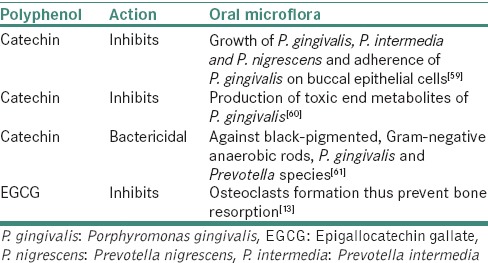
Table 5.
Effect of green tea on periodontium
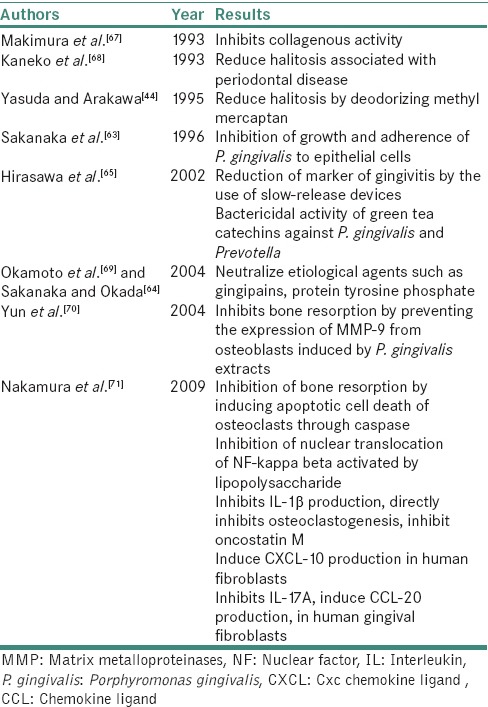
Oral cancer chemoprevention
The cancer promotion stage is a reversible and a long-term process, in which some intracellular signaling pathways and proteins associated with cell cycle are involved. Oncogene mutation and ROS play important roles in the initiation of cancer. Oncogene mutation leads to procarcinogen activation by activating some phase I enzymes such as the cytochrome P450s. ROS actively participate in the metabolic activation of procarcinogens. EGCG can neutralize these procarcinogens by inhibiting the activity of cytochrome P450 enzymes and modulating ROS. EGCG exerts its anticancer effect by interfering with many signaling pathways and modulating cell cycle [Figure 3].[72]
Figure 3.
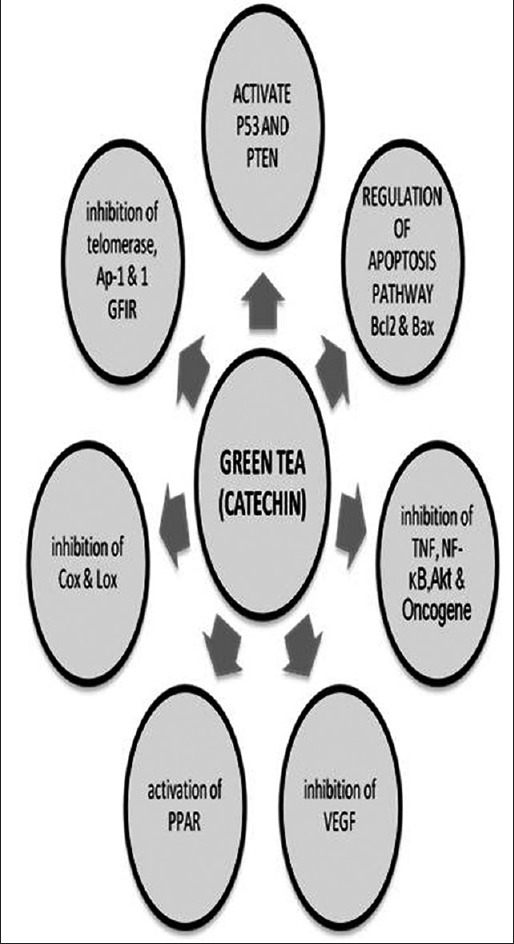
Signaling pathway in cancer modulated by green tea
Polyphenols may inhibit carcinogenesis in the stage of initiation, promotion or progression. In particular, dietary polyphenols decrease incidence of carcinomas and exert protection against oral cancer by induction of cell death and inhibition of tumor growth, invasion and metastasis.
The consumption of green tea is associated with a lower risk of several types of cancer, including stomach, esophagus and lung. The cancer chemopreventive effect of tea has been attributed to its major phytopolyphenols. The tea polyphenols comprise about one-third of the weight of the dried leaf, and they show profound biochemical and pharmacological activities including antioxidant activities, inhibition of cell proliferation, modulation of carcinogen metabolism, induction of cell apoptosis and cell cycle arrest. They intervene in the biochemical and molecular processes of multistep carcinogenesis. Recently, studies have found that the major tea polyphenol EGCG suppresses extracellular signals and cell proliferation through epidermal growth factor receptor (EGFR) binding in human A431 epidermoid carcinoma cells; EGCG also blocks the induction of nitric oxide synthase by downregulating lipopolysaccharide-induced activity of the transcription factor nuclear factor-κB (NF-κB) in macrophages. Furthermore, EGCG blocks the cell cycle at the G1 phase in MCF-7 cells. Lin JK in 1999 studied the EGCG inhibits the activities of cyclin-dependent kinases (cdks) 2 and 4; meanwhile, EGCG induces the expression of the Cdk inhibitors p21 and p27 and concluded that the tumor promotion can be enhanced by ROS and oxidative mitotic signal transduction, and this enhancement can be suppressed by EGCG or other tea polyphenols.[73] Ho HC in 2007 concluded that EGCG could inhibit the invasion and migration of human oral cancer cells and that the effects may partially because of the decreased productions of matrix metalloproteinase-2 (MMP-2), MMP-9 and urokinase-type plasminogen activator (uPA).[74] EGCG suppressed androgen receptor expression and signaling through several growth factor receptors. Cell cycle arrest or apoptosis involved caspase activation and altered Bcl-2 family member expression. EGCG inhibited telomerase activity and led to telomere fragmentation. At high concentrations, polyphenols had pro-oxidative activities, and at much lower levels, antioxidative effects occurred. EGCE reduces nitric oxide production and black tea theaflavins by suppressing inducible nitric oxide synthase through blocking nuclear translocation of the transcription factor NF-κB as a result of decreased kappa B kinase activity. Polyphenols up- or downregulated activity of a number of key enzymes, including mitogen-activated protein kinases and protein kinase C and increased or decreased protein/mRNA levels, including that of cyclins, oncogenes and tumor suppressor genes. Metastasis was inhibited through effects on urokinase and MMPs. Polyphenols reduced angiogenesis, in part by decreasing vascular endothelial growth factor (VEGF) production and receptor phosphorylation.[75]
Specifically, EGCG regulates expression of VEGF, insulin-like growth factor 1, EGFR, MMPs, uPA cell cycle regulatory proteins and inhibits NF-kB, PI3-K/Akt, Ras/Raf/MAPK and AP-1 signaling pathways, thereby causing strong cancer chemopreventive effects.[76] EGCG appears to have an immunosuppressive effect on the proliferation of peripheral blood mononuclear cells, indicating that EGCG also acts for immunomodulatory effects in autoimmune diseases and tissue transplantation.[18]
SIDE EFFECTS
The risks associated with a high dose of green tea are:
Drinking a large amount may cause neural tube birth defect in infants due to folic acid antagonism because of the presence of caffeine, catechins and tannic acids in green tea
Drinking tea or coffee stains or discolors the dental plaque but not the teeth itself
Increased bleeding time
Increased risk of bladder cancer[8]
Stain esthetic restorative material in oral cavity
Insomnia, anxiety, irritability, nausea and headaches
Stomach upset and diuresis
Heart irregularities, tremor and restlessness.
PRECAUTIONS
Patients such as pregnant or breast-feeding women, those with heart problems or increase blood pressure, stomach ulcers, kidney or liver problems or anxiety disorders, thyroid hyperfunction, elevated susceptibility to spasm and certain psychic disorders (e.g., panicky states of anxiety), should not take green tea supplements or extracts or should drink no more than one or two cups per day only because of the presence of caffeine in extracts.
CONCLUSION
Tea is most widely consumed beverage in the world because of its cooling, slightly bitter and astringent flavor that people enjoy. Tea can generally be divided into categories based on how they processed. Green tea nowadays becoming more pronounced among population in world due to its beneficial effects on human beings. In this modern world, dietary habits influence the risk of developing a variety of diseases, so drinking green tea is a relatively an easy and cheap habit to maintain a healthy life. It lowers the risk of diabetes, cardiovascular problems, obese and dental caries, etc.
As the human clinical evidence is still limited, future research needs to define the actual magnitude of health benefits. The development of various biomarkers as well as molecular markers for green tea consumption will facilitate future research in this area.
Financial support and sponsorship
Nil.
Conflicts of interest
There are no conflicts of interest.
REFERENCES
- 1.Cooper R, Morré DJ, Morré DM. Medicinal benefits of green tea: Part I. Review of noncancer health benefits. J Altern Complement Med. 2005;11:521–8. doi: 10.1089/acm.2005.11.521. [DOI] [PubMed] [Google Scholar]
- 2.Pastore RL, Fratellone P. Potential health benefits of green tea (Camellia sinensis): A narrative review. Explore (NY) 2006;2:531–9. doi: 10.1016/j.explore.2006.08.008. [DOI] [PubMed] [Google Scholar]
- 3.Cheng TO. All teas are not created equal: The Chinese green tea and cardiovascular health. Int J Cardiol. 2006;108:301–8. doi: 10.1016/j.ijcard.2005.05.038. [DOI] [PubMed] [Google Scholar]
- 4.McKay DL, Blumberg JB. The role of tea in human health: An update. J Am Coll Nutr. 2002;21:1–13. doi: 10.1080/07315724.2002.10719187. [DOI] [PubMed] [Google Scholar]
- 5.Hicks MB, Hsieh YH, Bell LN. Tea preparation and its influence on methylxanthine concentration. Food Res Int. 1996;29:325–30. [Google Scholar]
- 6.Cabrera C, Artacho R, Giménez R. Beneficial effects of green tea – A review. J Am Coll Nutr. 2006;25:79–99. doi: 10.1080/07315724.2006.10719518. [DOI] [PubMed] [Google Scholar]
- 7.Wu CD, Wei GX. Tea as a functional food for oral health. Nutrition. 2002;18:443–4. doi: 10.1016/s0899-9007(02)00763-3. [DOI] [PubMed] [Google Scholar]
- 8.Vinodh P, Shruthi BS. Tea: An oral elixir. Sch Acad J Pharm. 2014;3:9–18. [Google Scholar]
- 9.Ahmad N, Gupta S, Mukhtar H. Green tea polyphenol epigallocatechin-3-gallate differentially modulates nuclear factor kappaB in cancer cells versus normal cells. Arch Biochem Biophys. 2000;376:338–46. doi: 10.1006/abbi.2000.1742. [DOI] [PubMed] [Google Scholar]
- 10.Chen ZP, Schell JB, Ho CT, Chen KY. Green tea epigallocatechin gallate shows a pronounced growth inhibitory effect on cancerous cells but not on their normal counterparts. Cancer Lett. 1998;129:173–9. doi: 10.1016/s0304-3835(98)00108-6. [DOI] [PubMed] [Google Scholar]
- 11.Nakagawa H, Wachi M, Woo JT, Kato M, Kasai S, Takahashi F, et al. Fenton reaction is primarily involved in a mechanism of (-)-epigallocatechin-3-gallate to induce osteoclastic cell death. Biochem Biophys Res Commun. 2002;292:94–101. doi: 10.1006/bbrc.2002.6622. [DOI] [PubMed] [Google Scholar]
- 12.Moore RJ, Jackson KG, Minihane AM. Green tea (Camellia sinensis) catechins and vascular function. Br J Nutr. 2009;102:1790–802. doi: 10.1017/S0007114509991218. [DOI] [PubMed] [Google Scholar]
- 13.Osada K, Takahashi M, Hoshina S, Nakamura M, Nakamura S, Sugano M. Tea catechins inhibit cholesterol oxidation accompanying oxidation of low density lipoprotein in vitro. Comp Biochem Physiol Part C Toxicol Pharmacol. 2001;128:153–64. doi: 10.1016/s1532-0456(00)00192-7. [DOI] [PubMed] [Google Scholar]
- 14.Sudano Roccaro A, Blanco AR, Giuliano F, Rusciano D, Enea V. Epigallocatechin-gallate enhances the activity of tetracycline in staphylococci by inhibiting its efflux from bacterial cells. Antimicrob Agents Chemother. 2004;48:1968–73. doi: 10.1128/AAC.48.6.1968-1973.2004. [DOI] [PMC free article] [PubMed] [Google Scholar]
- 15.Weber JM, Ruzindana-Umunyana A, Imbeault L, Sircar S. Inhibition of adenovirus infection and adenain by green tea catechins. Antiviral Res. 2003;58:167–73. doi: 10.1016/s0166-3542(02)00212-7. [DOI] [PubMed] [Google Scholar]
- 16.Weinreb O, Mandel S, Amit T, Youdim MB. Neurological mechanisms of green tea polyphenols in Alzheimer's and Parkinson's diseases. J Nutr Biochem. 2004;15:506–16. doi: 10.1016/j.jnutbio.2004.05.002. [DOI] [PubMed] [Google Scholar]
- 17.Rasam P. Go green for healthy teeth and gums. Stud Dig. 2009;2:8–9. [Google Scholar]
- 18.Chatterjee A, Saluja M, Agarwal G, Alam M. Green tea: A boon for periodontal and general health. J Indian Soc Periodontol. 2012;16:161–7. doi: 10.4103/0972-124X.99256. [DOI] [PMC free article] [PubMed] [Google Scholar]
- 19.Kamath AB, Wang L, Das H, Li L, Reinhold VN, Bukowski JF. Antigens in tea-beverage prime human Vgamma 2Vdelta 2 T cells in vitro and in vivo for memory and nonmemory antibacterial cytokine responses. Proc Natl Acad Sci U S A. 2003;100:6009–14. doi: 10.1073/pnas.1035603100. [DOI] [PMC free article] [PubMed] [Google Scholar]
- 20.Shirai N, Suzuki H. Effects of Western, Vegetarian, and Japanese dietary fat model diets with or without green tea extract on the plasma lipids and glucose, and liver lipids in mice. A long-term feeding experiment. Ann Nutr Metab. 2004;48:95–102. doi: 10.1159/000077044. [DOI] [PubMed] [Google Scholar]
- 21.Niwattisaiwong N, Luo XX, Coville PF, Wanwimolruk S. Effects of Chinese, Japanese and Western tea on hepatic P450 enzyme activities in rats. Drug Metabol Drug Interact. 2004;20:43–56. doi: 10.1515/dmdi.2004.20.1-2.43. [DOI] [PubMed] [Google Scholar]
- 22.Sueoka N, Suganuma M, Sueoka E, Okabe S, Matsuyama S, Imai K, et al. A new function of green tea: Prevention of lifestyle-related diseases. Ann N Y Acad Sci. 2001;928:274–80. doi: 10.1111/j.1749-6632.2001.tb05656.x. [DOI] [PubMed] [Google Scholar]
- 23.Kavanagh KT, Hafer LJ, Kim DW, Mann KK, Sherr DH, Rogers AE, et al. Green tea extracts decrease carcinogen-induced mammary tumor burden in rats and rate of breast cancer cell proliferation in culture. J Cell Biochem. 2001;82:387–98. doi: 10.1002/jcb.1164. [DOI] [PubMed] [Google Scholar]
- 24.Koo MW, Cho CH. Pharmacological effects of green tea on the gastrointestinal system. Eur J Pharmacol. 2004;500:177–85. doi: 10.1016/j.ejphar.2004.07.023. [DOI] [PubMed] [Google Scholar]
- 25.Devine A, Hodgson JM, Dick IM, Prince RL. Tea drinking is associated with benefits on bone density in older women. Am J Clin Nutr. 2007;86:1243–7. doi: 10.1093/ajcn/86.4.1243. [DOI] [PubMed] [Google Scholar]
- 26.Haqqi TM, Anthony DD, Gupta S, Ahmad N, Lee MS, Kumar GK, et al. Prevention of collagen-induced arthritis in mice by a polyphenolic fraction from green tea. Proc Natl Acad Sci U S A. 1999;96:4524–9. doi: 10.1073/pnas.96.8.4524. [DOI] [PMC free article] [PubMed] [Google Scholar]
- 27.Venkateswara B, Sirisha K, Chava VK. Green tea extract for periodontal health. J Indian Soc Periodontol. 2011;15:18–22. doi: 10.4103/0972-124X.82258. [DOI] [PMC free article] [PubMed] [Google Scholar]
- 28.Okello EJ, Savelev SU, Perry EK. In vitro anti-beta-secretase and dual anti-cholinesterase activities of Camellia sinensis L.(tea) relevant to treatment of dementia. Phytother Res. 2004;18:624–7. doi: 10.1002/ptr.1519. [DOI] [PubMed] [Google Scholar]
- 29.Guo S, Yan J, Yang T, Yang X, Bezard E, Zhao B. Protective effects of green tea polyphenols in the 6-OHDA rat model of Parkinson's disease through inhibition of ROS-NO pathway. Biol Psychiatry. 2007;62:1353–62. doi: 10.1016/j.biopsych.2007.04.020. [DOI] [PubMed] [Google Scholar]
- 30.Nakayama M, Suzuki K, Toda M, Okubo S, Hara Y, Shimamura T. Inhibition of the infectivity of influenza virus by tea polyphenols. Antiviral Res. 1993;21:289–99. doi: 10.1016/0166-3542(93)90008-7. [DOI] [PubMed] [Google Scholar]
- 31.Sharangi AB. Medicinal and therapeutic potentialities of tea (Camellia sinensis L.) – A review. Food Res Int. 2009;42:529–35. [Google Scholar]
- 32.Coimbra S, Castro E, Rocha-Pereira P, Rebelo I, Rocha S, Santos-Silva A. The effect of green tea in oxidative stress. Clin Nutr. 2006;25:790–6. doi: 10.1016/j.clnu.2006.01.022. [DOI] [PubMed] [Google Scholar]
- 33.Maron DJ, Lu GP, Cai NS, Wu ZG, Li YH, Chen H, et al. Cholesterol-lowering effect of a theaflavin-enriched green tea extract: A randomized controlled trial. Arch Intern Med. 2003;163:1448–53. doi: 10.1001/archinte.163.12.1448. [DOI] [PubMed] [Google Scholar]
- 34.Donà M, Dell’Aica I, Calabrese F, Benelli R, Morini M, Albini A, et al. Neutrophil restraint by green tea: Inhibition of inflammation, associated angiogenesis, and pulmonary fibrosis. J Immunol. 2003;170:4335–41. doi: 10.4049/jimmunol.170.8.4335. [DOI] [PubMed] [Google Scholar]
- 35.Tyring SK. Effect of sinecatechins on HPV-activated cell growth and induction of apoptosis. J Clin Aesthet Dermatol. 2012;5:34–41. [PMC free article] [PubMed] [Google Scholar]
- 36.Lee MJ, Lambert JD, Prabhu S, Meng X, Lu H, Maliakal P, et al. Delivery of tea polyphenols to the oral cavity by green tea leaves and black tea extract. Cancer Epidemiol Biomarkers Prev. 2004;13:132–7. doi: 10.1158/1055-9965.epi-03-0040. [DOI] [PubMed] [Google Scholar]
- 37.Rasheed A, Haider M. Antibacterial activity of Camellia sinensis extracts against dental caries. Arch Pharm Res. 1998;21:348–52. doi: 10.1007/BF02975300. [DOI] [PubMed] [Google Scholar]
- 38.Matsumoto M, Minami T, Sasaki H, Sobue S, Hamada S, Ooshima T. Inhibitory effects of oolong tea extract on caries-inducing properties of mutans streptococci. Caries Res. 1999;33:441–5. doi: 10.1159/000016549. [DOI] [PubMed] [Google Scholar]
- 39.Serafini M, Ghiselli A, Ferro-Luzzi A. In vivo antioxidant effect of green and black tea in man. Eur J Clin Nutr. 1996;50:28–32. [PubMed] [Google Scholar]
- 40.Sweetman SC. Martindale: The complete drug reference. 34th ed. London: Pharmaceutical Press; 2005. [DOI] [PMC free article] [PubMed] [Google Scholar]
- 41.Yamamoto T, Juneja LR, Chu D, Kim M. Chemistry and Applications of Green Tea. Boca Raton, FL, USA: CRC Press; 1997. pp. 6–34. [Google Scholar]
- 42.Banker GS, Anderson NR. Tablets. In: Lachman L, Lieberman HA, Kanig JL, editors. The Theory and Practice of Industrial Pharmacy. 3rd ed. Philadelphia, PA: Lea and Febiger; 1986. pp. 293–345. [Google Scholar]
- 43.Moghbel A, Farjzadeh A, Aghel N, Agheli H, Raisi N. The effect of green tea on prevention of mouth bacterial infection, halitosis, and plaque formation on teeth. Iran J Toxicol. 2011;5:502–15. [Google Scholar]
- 44.Yasuda H, Arakawa T. Deodorizing mechanism of (-)-epigallocatechin against methyl mercaptan. Biosci Biotechnol Biochem. 1995;59:1232–6. [Google Scholar]
- 45.Sakanaka S, Kim M, Taniguchi M, Yammoto T. Antibacterial substance in Japnese green tea extract against streptococcus mutans, a cariogenic bacterium. Agric Biol Chem. 1989;53:2307–11. [Google Scholar]
- 46.Borgerding M, Klus H. Analysis of complex mixtures – Cigarette smoke. Exp Toxicol Pathol. 2005;57(Suppl 1):43–73. doi: 10.1016/j.etp.2005.05.010. [DOI] [PubMed] [Google Scholar]
- 47.Aoshiba K, Nagai A. Oxidative stress, cell death, and other damage to alveolar epithelial cells induced by cigarette smoke. Tob Induc Dis. 2003;1:219–26. doi: 10.1186/1617-9625-1-3-219. [DOI] [PMC free article] [PubMed] [Google Scholar]
- 48.Asadi E, Jahanshahi M, Golalipour MJ. Effect of Vitamin E on oocytes apoptosis in nicotine-treated mice. Iran J Basic Med Sci. 2012;15:880–4. [PMC free article] [PubMed] [Google Scholar]
- 49.Avti PK, Kumar S, Pathak CM, Vaiphei K, Khanduja KL. Smokeless tobacco impairs the antioxidant defense in liver, lung, and kidney of rats. Toxicol Sci. 2006;89:547–53. doi: 10.1093/toxsci/kfj041. [DOI] [PubMed] [Google Scholar]
- 50.Narotzki B, Reznick AZ, Aizenbud D, Levy Y. Green tea: A promising natural product in oral health. Arch Oral Biol. 2012;57:429–35. doi: 10.1016/j.archoralbio.2011.11.017. [DOI] [PubMed] [Google Scholar]
- 51.Nagaya N, Yamamoto H, Uematsu M, Itoh T, Nakagawa K, Miyazawa T, et al. Green tea reverses endothelial dysfunction in healthy smokers. Heart. 2004;90:1485–6. doi: 10.1136/hrt.2003.026740. [DOI] [PMC free article] [PubMed] [Google Scholar]
- 52.Huber LG. Green tea catechins and L-theanine in integrative cancer care: A review of the research. Altern Complement Ther. 2003;9:294–8. [Google Scholar]
- 53.Lung SC, Cheng HW, Fu CB. Potential exposure and risk of fluoride intakes from tea drinks produced in Taiwan. J Expo Sci Environ Epidemiol. 2008;18:158–66. doi: 10.1038/sj.jes.7500574. [DOI] [PubMed] [Google Scholar]
- 54.Ruan JY, Wong MH. Accumulation of fluoride and aluminium related to different varieties of tea plant. Environ Geochem Health. 2001;23:53–63. [Google Scholar]
- 55.Han YZ, Zhang JQ, Liu XY, Zhang LZ, Yu XH, Dai JA. High fluoride content of food and endemic fluorosis. Fluoride. 1995;28:201–2. [Google Scholar]
- 56.Cao J, Zhao Y, Liu J. Brick tea consumption as the cause of dental fluorosis among children from Mongol, Kazak and Yugu populations in China. Food Chem Toxicol. 1997;35:827–33. doi: 10.1016/s0278-6915(97)00049-5. [DOI] [PubMed] [Google Scholar]
- 57.Hayacibara MF, Queiroz CS, Tabchoury CP, Cury JA. Fluoride and aluminum in teas and tea-based beverages. Rev Saude Publica. 2004;38:100–5. doi: 10.1590/s0034-89102004000100014. [DOI] [PubMed] [Google Scholar]
- 58.Gradisar H, Pristovsek P, Plaper A, Jerala R. Green tea catechins inhibit bacterial DNA gyrase by interaction with its ATP binding site. J Med Chem. 2007;50:264–71. doi: 10.1021/jm060817o. [DOI] [PubMed] [Google Scholar]
- 59.Prabhakar J, Senthilkumar M, Priya MS, Mahalakshmi K, Sehgal PK, Sukumaran VG. Evaluation of antimicrobial efficacy of herbal alternatives (Triphala and green tea polyphenols), MTAD, and 5% sodium hypochlorite against Enterococcus faecalis biofilm formed on tooth substrate: An in vitro study. J Endod. 2010;36:83–6. doi: 10.1016/j.joen.2009.09.040. [DOI] [PubMed] [Google Scholar]
- 60.Nakanishi T, Mukai K, Yumoto H, Hirao K, Hosokawa Y, Matsuo T. Anti-inflammatory effect of catechin on cultured human dental pulp cells affected by bacteria-derived factors. Eur J Oral Sci. 2010;118:145–50. doi: 10.1111/j.1600-0722.2010.00714.x. [DOI] [PubMed] [Google Scholar]
- 61.Li N, Sun Z, Han C, Chen J. The chemopreventive effects of tea on human oral precancerous mucosa lesions. Proc Soc Exp Biol Med. 1999;220:218–24. doi: 10.1046/j.1525-1373.1999.d01-37.x. [DOI] [PubMed] [Google Scholar]
- 62.Chow HH, Hakim IA. Pharmacokinetic and chemoprevention studies on tea in humans. Pharmacol Res. 2011;64:105–12. doi: 10.1016/j.phrs.2011.05.007. [DOI] [PMC free article] [PubMed] [Google Scholar]
- 63.Sakanaka S, Aizawa M, Kim M, Yamamoto T. Inhibitory effects of green tea polyphenols on growth and cellular adherence of an oral bacterium, Porphyromonas gingivalis. Biosci Biotechnol Biochem. 1996;60:745–9. doi: 10.1271/bbb.60.745. [DOI] [PubMed] [Google Scholar]
- 64.Sakanaka S, Okada Y. Inhibitory effects of green tea polyphenols on the production of a virulence factor of the periodontal-disease-causing anaerobic bacterium Porphyromonas gingivalis. J Agric Food Chem. 2004;52:1688–92. doi: 10.1021/jf0302815. [DOI] [PubMed] [Google Scholar]
- 65.Hirasawa M, Takada K, Makimura M, Otake S. Improvement of periodontal status by green tea catechin using a local delivery system: A clinical pilot study. J Periodontal Res. 2002;37:433–8. doi: 10.1034/j.1600-0765.2002.01640.x. [DOI] [PubMed] [Google Scholar]
- 66.Kushiyama M, Shimazaki Y, Murakami M, Yamashita Y. Relationship between intake of green tea and periodontal disease. J Periodontol. 2009;80:372–7. doi: 10.1902/jop.2009.080510. [DOI] [PubMed] [Google Scholar]
- 67.Makimura M, Hirasawa M, Kobayashi K, Indo J, Sakanaka S, Taguchi T, et al. Inhibitory effect of tea catechins on collagenase activity. J Periodontol. 1993;64:630–6. doi: 10.1902/jop.1993.64.7.630. [DOI] [PubMed] [Google Scholar]
- 68.Kaneko K, Shimano N, Suzuki Y, Nakamukaim, Ikazaki R, Ishida N, et al. Effects of tea catechins on oral odor and dental plaque. J Oral Ther Pharmacol. 1993;12:189–97. [Google Scholar]
- 69.Okamoto M, Sugimoto A, Leung KP, Nakayama K, Kamaguchi A, Maeda N. Inhibitory effect of green tea catechins on cysteine proteinases in Porphyromonas gingivalis. Oral Microbiol Immunol. 2004;19:118–20. doi: 10.1046/j.0902-0055.2003.00112.x. [DOI] [PubMed] [Google Scholar]
- 70.Yun JH, Pang EK, Kim CS, Yoo YJ, Cho KS, Chai JK, et al. Inhibitory effects of green tea polyphenol (-)-epigallocatechin gallate on the expression of matrix metalloproteinase-9 and on the formation of osteoclasts. J Periodontal Res. 2004;39:300–7. doi: 10.1111/j.1600-0765.2004.00743.x. [DOI] [PubMed] [Google Scholar]
- 71.Nakamura H, Ukai T, Yoshimura A, Kozuka Y, Yoshioka H, Yoshinaga Y, et al. In vivo Green tea catechin inhibits lipopolysaccharide-induced bone resorption. J Periodontal Res. 2009;45:23–30. doi: 10.1111/j.1600-0765.2008.01198.x. [DOI] [PubMed] [Google Scholar]
- 72.Chen L, Zhang HY. Cancer preventive mechanisms of the green tea polyphenol (-)-epigallocatechin-3-gallate. Molecules. 2007;12:946–57. doi: 10.3390/12050946. [DOI] [PMC free article] [PubMed] [Google Scholar]
- 73.Lin JK, Liang YC, Lin-Shiau SY. Cancer chemoprevention by tea polyphenols through mitotic signal transduction blockade. Biochem Pharmacol. 1999;58:911–5. doi: 10.1016/s0006-2952(99)00112-4. [DOI] [PubMed] [Google Scholar]
- 74.Ho YC, Yang SF, Peng CY, Chou MY, Chang YC. Epigallocatechin-3-gallate inhibits the invasion of human oral cancer cells and decreases the productions of matrix metalloproteinases and urokinase-plasminogen activator. J Oral Pathol Med. 2007;36:588–93. doi: 10.1111/j.1600-0714.2007.00588.x. [DOI] [PubMed] [Google Scholar]
- 75.Beltz LA, Bayer DK, Moss AL, Simet IM. Mechanisms of cancer prevention by green and black tea polyphenols. Anticancer Agents Med Chem. 2006;6:389–406. doi: 10.2174/187152006778226468. [DOI] [PubMed] [Google Scholar]
- 76.Saleh F, Raghupathy R, Asfar S, Oteifa M, Al-Saleh N. Analysis of the effect of the active compound of green tea (EGCG) on the proliferation of peripheral blood mononuclear cells. BMC Complement Altern Med. 2014;14:322. doi: 10.1186/1472-6882-14-322. [DOI] [PMC free article] [PubMed] [Google Scholar]



